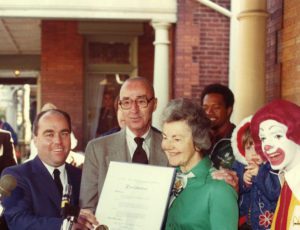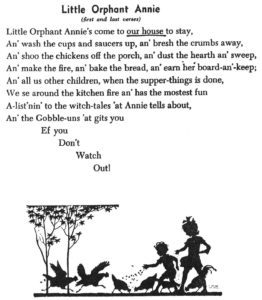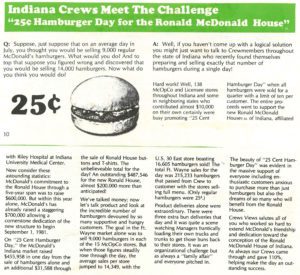Celebrating 40 Years, Together

On October 14, 1982, the Ronald McDonald House of Indiana opened on the campus of IUPUI just a short walk from the renowned Riley Children’s Hospital. It was the realization of efforts that had started more than five years earlier.
The concept of the Ronald McDonald House debuted in Philadelphia in the mid-1970s. Fred Hill, a linebacker for the Philadelphia Eagles, and his wife, Fran, had been enduring the stress of watching their daughter Kimberly receive treatment for acute lymphatic leukemia at Children’s Hospital of Philadelphia. The Hills, like many families before them, were spending their time camped in the hospital, sleeping in lounges or their child’s room. Together with Dr. Audrey Evans, head of pediatric oncology at Children’s Hospital of Philadelphia, the Hills worked alongside the Philadelphia Eagles to raise more than $125,000 to develop a new oncology center for the hospital.

Dr. Evans at the grand opening of the Philadelphia Ronald McDonald House in 1974. Photo courtesy RMHC Philadelphia.
Driven to do more and to provide a place of respite for families, the cadre continued their efforts, eventually enlisting the expertise of McDonald’s advertising executive Don Tuckerman. McDonald’s enthusiastically supported the idea of creating a home away from home for families like the Hills, and held a special Shamrock Shake sale as a fundraiser to bring the idea to life. Ever the visionary, Dr. Evans had already scouted out the perfect house near the hospital. With $35,000 from the fundraiser in hand, the house was renovated, and the first Ronald McDonald House was born. It opened on October 15, 1974. Three years later, the second Ronald McDonald House opened in Chicago, IL. Word of this innovative approach in family-centered care spread like wildfire.
The Three-Legged Stool
The development of the first two Ronald McDonald Houses demonstrated that success hinged on the buy-in and participation from three core groups: a partnering hospital, local McDonald’s restaurants and corporate employees, and the community. The concept became known as the “crucial triangle,” or “three-legged stool.”
In Indiana, the three-legged stool would become personified by nine individuals, three from each of the core groups.
Riley Children’s Health
- Dr. Steven Beering
- James and Cheri Forslund
- Charles Richmond
McDonald’s
- Gerald Cassidy
- Brenda Duncan
- Jim Props
The Indianapolis Community
- Karen Campbell
- Gordon Durnill
- Judy Monnier

The opening verse of James Whitcomb Riley’s “Little Orphant Annie”.
Ronald McDonald House of Indiana’s early leaders would eventually incorporate as Our House, Inc. named after the poem “Little Orphant Annie” written by Riley Hospital namesake, James Whitcomb Riley. The poem opens, “Little Orphant Annie’s come to our house to stay…” As part of our 40th anniversary celebration, we will be highlighting accounts from our living founders.
A Vision for the House
The crucial triangle now formed, the founding board members set forth to introduce the Ronald McDonald House (RMH) model to the citizens of Indiana and garner the financial support that would be necessary to make the vision a reality. The board estimated it would cost about $1.6 million to open the House, and they set the goal of opening entirely debt-free. In December 1980, Dr. Beering brokered a deal with IUPUI leadership for the land necessary for the House. His fellow board members credited him with opening doors and fostering the relationships that allowed the House to open in just two years.
With a signed lease and blueprints for the House, the Our House, Inc. board launched a statewide PR campaign led with strategic expertise from PR giants, Caldwell Van Riper (CVR). Building on the concepts of creating a home away from home for families, Our House, Inc. was able to secure financial support from McDonald’s franchisees, Lilly Endowment, and even McDonald’s founder Ray Kroc. Karen Campbell, Cheri Forslund, Judy Monnier, and several others fostered community support by speaking at religious and fraternal organizations, talking to “anyone who’d listen.”
The fundraisers held from 1980 through 1982 are too numerous to list. They include button sales, a telethon, parades, and bake sales. By October 1982, with a last-minute anonymous donation of $80,000, Our House, Inc. reached its goal of raising $1.8 million, and the House opened debt-free on October 14.
August 2, 1981 – 25 Cents Hamburger Day
25¢ Hamburger Day – the name says it all. For one day only, McDonald’s would offer customers as many burgers as they could eat for just a quarter each – and all the money would go towards building the Ronald McDonald House in Indianapolis. As soon as restaurants opened, they were quickly swamped with customers lined up out the doors and into parking lots. Jim Props recalled the burgers selling “in increments of ten, twenty, fifty, and occasionally a hundred.”

The success of 25 cent Hamburger Day is lauded in the September, 1981 edition of McDonalds’ Crew Views
One overwhelmed operator pleaded with the event’s support hotline, “I have opened my last case of meat. What do I do?” On the other end of the line, the staffer could only muster, “Are there any cows outside?” McDonald’s bakeries were delivering buns so fresh they were still hot. Some owners resorted to scouring local grocery store shelves for meat and bread. One grill buckled under the pressure and “went up in flames.”
It was an unmitigated success. By the time the day ended, McDonald’s 144 stores had sold 1,668,671 hamburgers, raising an astonishing $455,958.51 ($1,710,600 in today’s dollars), as well as an additional $31,588 raised through the sale of t-shirts and buttons, making it the biggest fundraiser held for a Ronald McDonald House at the time.
Celebrating 40 Years
To celebrate the 40th anniversary of Ronald McDonald House Charites of Central Indiana, we launched 40 From our 40, a storytelling initiative that showcases stories, memories and moments from 40 individuals that have had an experience with RMHCCIN in the past 40 years. These interviews will be share in the print and online editions of Heart & Hearth.
Attribution
Christopher Mize’s Master of Arts thesis paper and oral history, “A History of the Ronald McDonald House of Indiana, 1980-2004″ served as the source for this article. Mize conducted historical research and interviews of RMH stakeholders from 2009 through 2012.